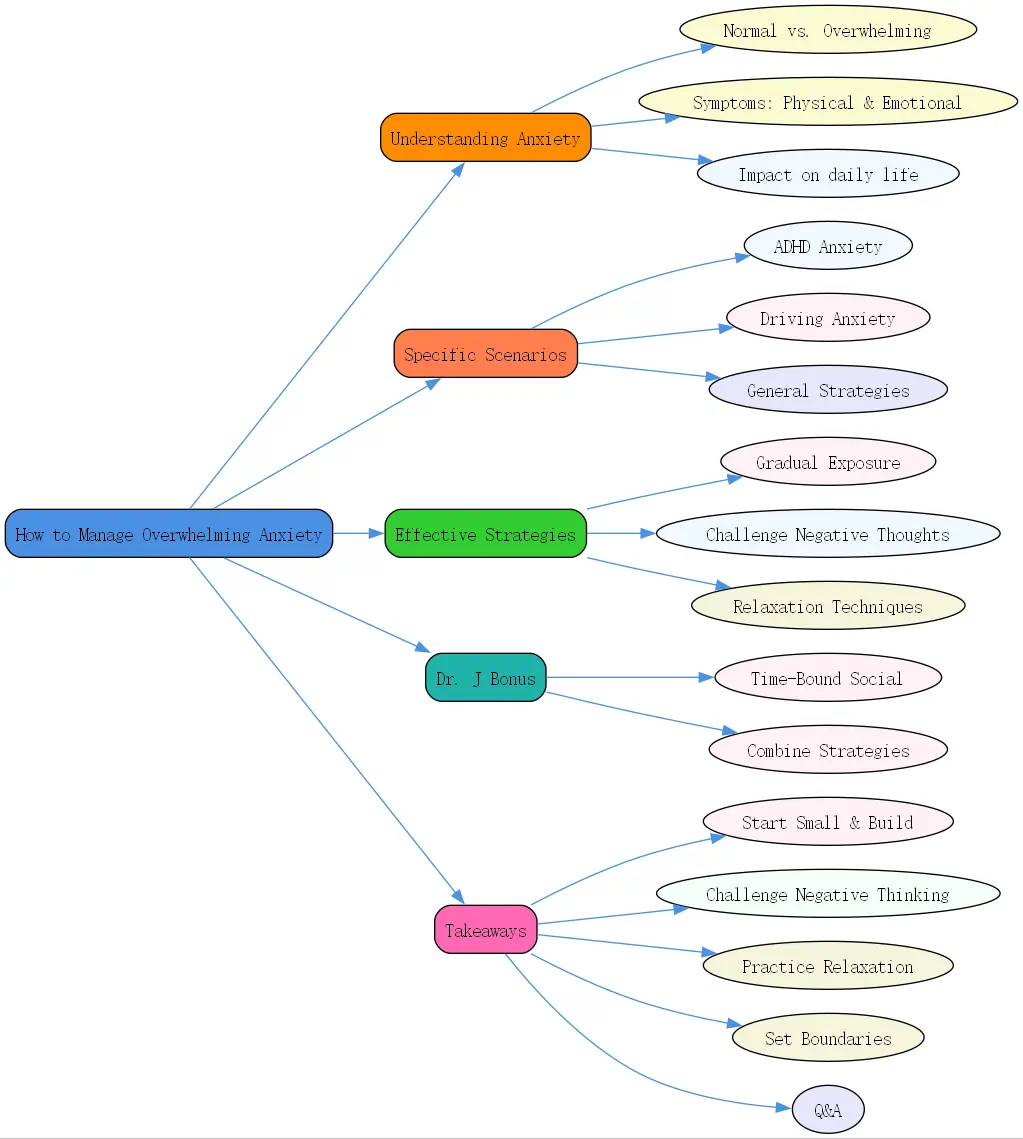Learn how to manage overwhelming anxiety with actionable strategies for ADHD, social settings, and driving. Expert tips grounded in psychology.
How to Manage Overwhelming Anxiety: A Comprehensive Guide

Anxiety is a normal response to stress, but when it becomes overwhelming, it can have a profound impact on daily life. Whether you’re dealing with social anxiety, ADHD-related anxiety, or specific fears such as driving anxiety, the ripple effects can disrupt your relationships, work, and overall well-being.
At BrainTalking, we aim to provide actionable advice for navigating anxiety in ways that empower you to regain control. In this guide, we’ll explore how to manage overwhelming anxiety, break down specific scenarios like ADHD anxiety and driving anxiety, and equip you with proven strategies to reduce stress.
Understanding Anxiety and Its Impact
Defining Anxiety: Differentiating Between Normal Stress and Overwhelming Anxiety
Anxiety, at its core, is your body’s natural response to potential threats. It’s normal to feel some level of anxiety before significant events like a job interview or meeting new people. However, overwhelming anxiety differs in intensity, frequency, and duration. It often causes heightened fear and physical symptoms that persist, interfering with your ability to function.
The Physical and Emotional Symptoms of Anxiety
The symptoms of anxiety manifest both mentally and physically. These include racing thoughts, difficulty concentrating, a rapid heartbeat, sweaty palms, and restlessness. Emotionally, anxiety often brings a sense of dread, fear of judgment, and feelings of inadequacy.
How Anxiety Affects Daily Life, Relationships, and Work

Overwhelming anxiety can seep into every aspect of your life. It affects personal relationships when fear of judgment or perceived inadequacy builds walls between loved ones. At work, it manifests as procrastination, avoidance, or poor focus on important tasks. Left unaddressed, overwhelming anxiety significantly diminishes quality of life.
Specific Anxiety Scenarios and Solutions
How to Manage ADHD Anxiety
Living with ADHD often includes juggling attention dysregulation, impulsivity, and emotions, which can exacerbate anxiety. Here’s how these conditions intersect and what you can do to cope:
- The Connection Between ADHD and Anxiety
ADHD and anxiety disorders often coexist. Social expectations, executive functioning struggles, and mood-dependent behaviors can heighten anxiety for women with ADHD. For example, anxiety might stem from forgetting commitments or not meeting societal expectations to be organized and 鈥減ut-together.??
- Strategies for Managing ADHD-Related Anxiety
Start by breaking tasks into smaller, manageable steps and practicing mindfulness exercises, which can help you focus on the present moment. Additionally, cognitive-behavioral therapy (CBT) techniques can help identify thought patterns that worsen anxiety.
- Managing Impulsivity and Mood-Dependent Behaviors
Consciously pause and self-check when making decisions. Gradual exposure therapy (starting small and progressively building up your tolerance) can help you face triggering situations effectively.
How to Manage Driving Anxiety
Driving anxiety, whether caused by past trauma, fear of accidents, or sensory overload, can make daily commutes daunting. Here’s how to manage this fear:

- Understanding Driving Anxiety Triggers
You might feel overwhelmed by traffic, highway driving, or the pressure of being surrounded by other vehicles. Identify your specific triggers to tackle them head-on.
- Techniques to Calm Nerves While Driving
Before driving, practice deep breathing (inhaling through the nose for four seconds, holding for seven, and exhaling for eight). This calms your nervous system. Additionally, visualize successful driving scenarios to build positive mental associations.
- Practical Tips for Making Driving Manageable
Start small by driving short, low-stress routes. Gradually expand to more challenging scenarios, such as driving during busy hours, to build confidence over time. Another strategy is to have a trusted passenger accompany you to ease your mind.
General Strategies on How to Manage Anxiety
For any type of anxiety, general techniques can be a lifeline:
- Identifying and Challenging Negative Thoughts
Anxiety thrives on catastrophic thinking, such as 鈥淚’ll fail, and everyone will judge me.??Challenge this by asking yourself: What evidence supports this fear? What’s the worst-case scenario, and how likely is it to occur?
- Utilizing Relaxation Techniques
Mindfulness, progressive muscle relaxation, and 4-7-8 breathing techniques effectively combat physical symptoms of anxiety. Start practicing these techniques daily instead of waiting for moments of stress.
- How to Manage Social Gatherings
Gradual exposure is particularly useful here. Begin by attending smaller gatherings where you feel more comfortable. Over time, expand to larger events. Apply time-limited commitments (e.g., staying an hour) to make social interactions feel manageable.
Effective Strategies for Managing Anxiety
Gradual Exposure Techniques
- The Step-by-Step Approach to Facing Fears
Gradual exposure involves confronting anxiety-inducing situations one step at a time. Start with manageable tasks, such as greeting a cashier or speaking to a coworker, before advancing to larger challenges like presenting in meetings or attending social events.
- Examples of Gradual Exposure in Social Situations
Emma, who struggles to engage with strangers, begins by saying 鈥渉ello??to her barista. Over time, she progresses to small talk with coworkers. Eventually, Emma gains the confidence to initiate conversations at company events.
Challenging Negative Thought Patterns
- Identifying and Reframing Catastrophic Thinking
 Recognize thoughts like, 鈥淚’ll make a fool of myself.??Reframe them by considering past successes or input from trusted friends. Ask yourself, 鈥淚s it realistic to assume the worst every time???
Recognize thoughts like, 鈥淚’ll make a fool of myself.??Reframe them by considering past successes or input from trusted friends. Ask yourself, 鈥淚s it realistic to assume the worst every time???
- Using Evidence to Counter Negative Thoughts
Imagine Jennifer preparing for a work presentation. She overcomes her fear by reminding herself of past presentations that went well and practicing thoroughly to minimize possible mistakes.
Relaxation Techniques for Anxiety Relief
- Deep Breathing Exercises
Techniques like 4-7-8 breathing slow the heart rate and reduce physical tension. Take this practice beyond moments of anxiety鈥攅mbed it in your daily routine.
- Mindfulness Practices
Mindfulness centers you in the present. Start with short, guided practices via apps or YouTube. Over time, mindfulness improves focus and reduces overthinking.
- Progressive Muscle Relaxation
Focus on tensing and relaxing different muscle groups, starting at your toes and working upward. This method breaks the physical symptoms of anxiety by promoting body awareness and relaxation.
The Dr. J Bonus: Time-Bound Social Engagements
Putting a Clock on Social Situations
Social settings can feel overwhelming, but time-limited participation gives you control. Suppose you’re invited to a gathering. Commit to staying for just 30 minutes to an hour. This makes the situation less daunting and often results in staying longer than planned as anxiety fades.
Combining Strategies for Maximum Effectiveness
Integrating techniques creates a powerful synergy. For example:
- Begin with relaxation techniques (to lower physical anxiety).
- Use reframed thoughts to counter anticipatory fears.
- End with gradual exposure to build resilience over time.
Remember, these methods aren’t one-size-fits-all. Tailor each strategy to suit your needs and specific triggers.
Takeaways: How to Manage Overwhelming Anxiety
1. Start Small and Build: Use gradual exposure to face fears one step at a time. 2. Challenge Negative Thinking: Replace catastrophizing with evidence-based reasoning. 3. Practice Relaxation Tools: Engage in breathing exercises or mindfulness regularly. 4. Set Boundaries: Time-box social engagements to reduce feelings of obligation.
By incorporating these techniques, you’ll create a toolkit to tackle anxiety proactively.
Q&A: Addressing a Common Question about Anxiety
Q: How do I know when my anxiety requires professional help? A: Seek professional help if your anxiety:
- Lasts longer than six months
- Interferes with daily tasks, relationships, or work
- Causes physical symptoms like nausea or uncontrollable shaking
- Makes situations feel unmanageable despite self-help strategies
It’s crucial to differentiate clinical anxiety from manageable stress. If in doubt, consult a licensed mental health professional.
At BrainTalking, we strive to bridge the gap between psychological research and everyday challenges. With expert guidance and personalized strategies, you’re never alone in managing anxiety effectively.




